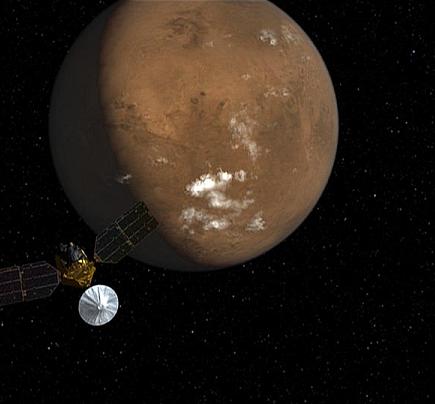For the next six months, the spacecraft will carefully descend into the Martian atmosphere in a process known as air braking. The process will shrink the route from an oval today to an almost circular route that will last two hours

Saturday - 9:00 + 11:00
It is now clearly known: MRO is in orbit around Mars. The entry into orbit was made yesterday after midnight (according to GMT), and after many maneuvers by the spacecraft. At JPL, NASA breathed a sigh of relief when the spacecraft signaled to them that all was well, and left the shadow of Mars. From now on, it will orbit the planet in low orbit for two years, and is expected to collect the most detailed information ever collected about Mars.
For the next six months, the spacecraft will carefully descend into the Martian atmosphere in a process known as air braking. The process will shrink the route from an oval today to an almost circular route that will last two hours. In the scientific phase of the mission, which will begin in November, the spacecraft will orbit Mars in a circular orbit at an altitude of 255 to 320 km, lower than any previous satellite that orbited Mars. If NASA wanted to reach such an orbit directly without using air braking, the spacecraft would have to carry 70 percent more fuel.
The instruments on the spacecraft will study Mars from this low altitude. The spacecraft will map water-bound minerals the size of the infield of a baseball (or football) field. The radar device will provide data on the underground layers of rocks and water. One telescopic camera will take pictures the size of a card table. Another camera will shoot at a lower resolution to allow scientists to find the context of the detailed images. A color camera will analyze the entire planet and monitor weather changes. A radiometer will examine each layer in the atmosphere and map the changes in temperature, water vapor and dust.
"The mission relies on the data we know from previous missions and now we will try to find when there was water on the surface of Mars and where it disappeared." said Dr. Richard Zurk, mission scientist at JPL. "Water is an essential factor for life so this could help focus future studies on whether Mars could have ever supported life."
The spacecraft will also transmit to Earth at 10 times the speed of previous spacecraft. Besides transmitting images and other data to Earth from its Yaha devices, it will also serve as a relay station for the ground missions - both the current ones (Spirit and Opportunity) and the Phoenix mission planned for launch in 2007 and the Mars scientific laboratory currently under development and planned for launch in 2009.
23:15
Today, Friday afternoon, the spacecraft ignited its engines and slowed its speed. In doing so, she began the stages of entering orbit around the planet Mars.
"As exciting as it is, it's a little nerve-wracking," said Doug McQuestion, who heads the Mars program at NASA headquarters.
Update before the sale - Friday 15:00
The American space agency NASA is under stress. Today at 23:24 p.m., the control personnel of the Mars Reconnaissance Orbiter (MRO) at NASA's Jet Propulsion Laboratory (JPL), together with Lockheed-Martin personnel, are supposed to turn on its engines to slow down its speed and allow the gravity of Mars to capture It is in an orbital orbit. The spacecraft is supposed to enter an elliptical orbit that will bring it closer to the surface of Mars about 500 times in the next six months, during which it will be further slowed by the atmosphere in a process known as "air braking." Eventually, it will move to a near-circular orbit that is best suited for The six instruments on board MRO flew about 500 million km over seven months to reach its goal.
If all goes as planned, the spacecraft will begin in November this year to study the Martian atmosphere, special formations on the surface and the underground geological structure.
10/3/06 The MRO spacecraft is scheduled to enter orbit around Mars today
The American agency NASA is under stress. Today at 23:24 p.m., the control personnel of the Mars Reconnaissance Orbiter (MRO) at NASA's Jet Propulsion Laboratory (JPL), together with Lockheed-Martin personnel, are supposed to turn on its engines to slow down its speed and allow the gravity of Mars to capture It is in an orbital orbit. The spacecraft is supposed to enter an elliptical orbit that will bring it closer to the surface of Mars about 500 times in the next six months, during which it will be further slowed by the atmosphere in a process known as "air braking." Eventually, it will move to a near-circular orbit that is best suited for The six instruments on board MRO flew about 500 million km over seven months to reach its goal.
If all goes as planned, the spacecraft will begin in November this year to study the Martian atmosphere, special formations on the surface and the underground geological structure.
Ydan Mars
https://www.hayadan.org.il/BuildaGate4/general2/data_card.php?Cat=~~~993719597~~~16&SiteName=hayadan

2 תגובות
Do not laugh at him
You didn't explain anything